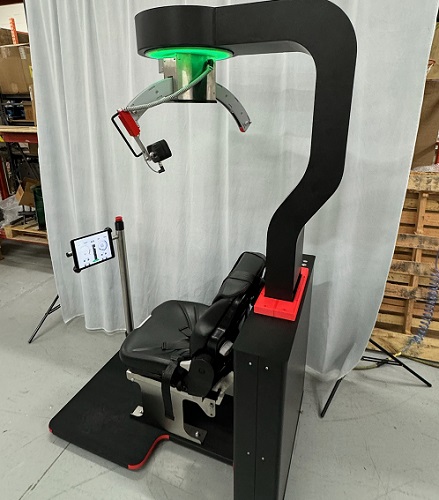
For many an opposing NHL player, Nick Foligno can be something of a “pain in the neck”.
Now the Sudbury resident and veteran of more than 1150 NHL games is teaming up with a handful of individuals in helping to promote and market a device that tackles that idiom much more literally, with the hopes of addressing athletic concussions (and others) in a very big way.
Foligno’s involvement with this project can be traced back to long-time friend and athletic therapist Kim Brouzes, a woman familiar with a large number of Sudbury’s top athletes and now CEO of a new start-up called Kinmetrix.
Along with Nova Scotia chiropractor Bill Smith (who essentially came up with the vision) and Sudbury physician and entrepreneur Dennis Reich, and with some financial support from the Sudbury Catalyst Fund, the group are now bringing the Kinmetrix Arc to market.
Historically, strengthening the neck muscles has relied little on the way of scientific research – creating a huge gap in the sport industry given the ever-increasing awareness of the interrelation between the strength of neck muscles and the ability to better protect athletes against the risk of concussions.
“One percent more strength in neck muscles reduces the likelihood of concussions by 5%,” noted Brouzes, chatting recently at her clinic in the building that houses the Laurentian University fieldhouse. “But we don’t often strengthen the neck because it’s risky.”
It is the science behind the Arc that has Brouzes and company most excited.
“This is the only neck strength device in the works that will actually take data – and we can program it so that the entire arc (each rotational angle) is controlled,” she said. “We can assess weaknesses in the muscle groups and then use the device to strengthen those weaknesses. And we can test the strength in all cardinal ranges.”
Ironically, the device was conceived, to some extent, by a confluence of events for Bill Smith, a practicing Doctor of Chiropractic Medicine for more than 20 years now – including mounting frustration over the lack of quantitative measures in dealing with neck injuries and a quasi-epiphany stemming from a patient’s cross-country trip, by motorcycle, that somehow aided concussion rehabilitation.
Still, the Sudbury ties to the undertaking are strong.
While Smith originally created what was dubbed Neck Tronics, a redesigned version of the device that is being shipped to the likes of the Chicago Blackhawks, the Cleveland Browns, Kent State University and personal trainer and former NHL Gary Roberts is being built at the NORCAT facility in New Sudbury.
“They have taken the initial device and redesigned it to be shipped out,” said Brouzes.
At the moment, the Arc that currently sits in her office at L.U. is but one of a small handful that exist in the world, the group still discovering ways in which to optimize the usage of the collection of data and, through that, the benefits that accrue to the end users.
For her part, Brouzes is not the least bit surprised that world-class innovation in countless aspect of sport science occurs right here in the home of the Big Nickel.
“People in Sudbury will work twice as hard, trying to match what is happening in other parts of the world,” she said. “People in Sudbury are passionate; they’re hard working; and they’re doing everything they can to make Sudbury a better place.”







